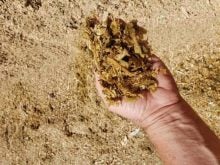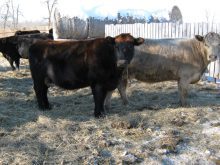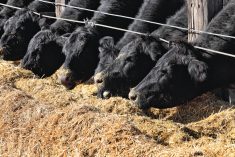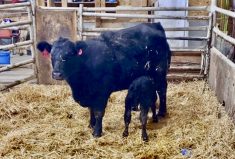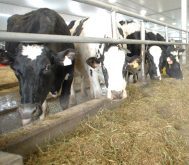I use a lot of soybean meal in several of the lactating feeding programs I develop for high-milk-producing dairy cows. However, in recent months, the skyrocketing price of soybeans has caused me to reconsider. So, I have replaced a significant portion of soybean meal with canola meal, yet have retained the economics and production in several dairies.
Aside from price, I can formulate canola meal and/or soybean meal almost interchangeably in my lactating dairy diets — both as primary sources of crude protein (CP) and a somewhat secondary source of rumen undegradable or ‘bypass’ protein’ (RUP). That’s because canola meal has a protein content of about 41 per cent and a bypass protein of 30-35 per cent (UIP per cent, CP), which in turn has a 75 per cent degradability in the lower gut.
Read Also

Harvest wraps up and fall work begins
At the Eppich famly ranch in western Saskatchewan, the fall harvest was successful with few breakdowns, cows and calves have been sorted and a new tractor has arrived
These nutrient specs are comparable to soybean meal, with a consistent protein content of 51 per cent and a bypass protein level of 35 per cent (UIP per cent, CP), which is nearly all digested (94 per cent) in the lower gut. Finally, both ingredients have a measured dietary energy (Nel) value of 1.80-1.90 Mcal/kg, which is slightly less than corn and cereal grains.
Some researchers and fellow nutritionists might take exception to these nutrient values, since many of them believe canola meal is a much better choice over soybean meal in lactating dairy diets. They often argue that it is no longer valid that soluble protein in most feedstuffs like canola meal is equated to rumen-degradable protein, but a portion of soluble protein actually adds to the value of their bypass protein. As a result, canola meal should have a higher RUP value of 44 per cent, which is higher than soybean meal’s RUP. Furthermore, these people say that older formulating models compute the indigestible lignin of canola meal in error, which also underestimates canola meal’s dietary energy value as mentioned above.
As good supporting evidence, the University of Saskatchewan (2017) reported a literature review of 49 studies in which canola meal replaced a group of commonly used protein sources and soybean meal in lactating dairy diets at up to 20 per cent (dm basis). Cows fed canola meal as dietary protein replacement (crude protein and bypass) had increased milk production — 0.7 kg per day (soybean meal) and 1.4 kg (other protein sources). In some of these trials where soybean meal was replaced with canola meal, milk urea nitrogen (MUN) levels were lower and overall feed efficiency of the dairy diet improved.
In addition, South Dakota University (2009) formulated canola meal as a total and a partial protein substitute of corn dried distiller’s grains with solubles (DDGS-30 per cent crude protein, 62 per cent bypass protein) in a common diet for 12 early/multi-lactation dairy cows. The respective treatments were 100, 66, 33, and 0 per cent replacement protein, which resulted in milk production and its components to be similar for all such treatments. The researchers concluded that canola meal was a suitable replacement for DDGS in most lactation dairy diets.
Such evidence might even convince me that canola is a more nutritious protein source than soybean meal or DDGS for good milk production. However, its wider acceptance by dairy farmers is likely based upon its economic advantage compared to these protein feed ingredients to make milk. I often calculate the cost of canola meal protein as well as its bypass protein (RUP) and compare them with those of soybean meal and DDGS:
- Canola ml protein (36 per cent CP, as fed) = $ 465 mt/.36 = $ 1,292/mt vs Soybean ml (47 per cent CP, as fed) = $690/.47 = $ 1468/mt
- Canola ml RUP (35 per cent of CP, as fed) = $ 465 mt/.36/.35 = $ 3,690/mt vs Soybean ml RUP (35 per cent of CP, as fed) = $690/.47/.35 = $ 4194/mt
- Canola ml protein (36 per cent CP, as fed) = $ 465 mt/.36 = $ 1,292 mt vs DDGS (28 per cent CP, as fed) = $410/.28 = $ 1464/mt
- Canola ml RUP (35 per cent of CP, as fed) = $465 mt/.36/.35 = $ 3,690 mt vs DDGS RUP (60 per cent of CP, as fed) = $410/.28/.60 = $2,440/mt
These are straightforward feed costs to review when formulating canola meal as a nutritious yet economical feed ingredient in lactating dairy diets. In a recent dairy feeding program I revised, I substituted one kilogram of soybean meal ($0.69) for 1.2 kg of canola meal ($0.49) in the lactating dairy diet and saved about $0.20 per lactating cow per day. For this 200-milking cow dairy, this little change saved the dairy producer — about $1,200 per month.




